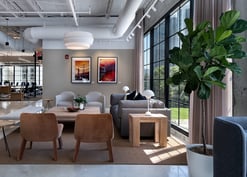The landscape of healthcare design is experiencing a transformative shift that prioritizes the experiences of both patients and caregivers. At the 2024 Healthcare Design Conference, discussions underscored the importance of integrating cohesive design, art, and technology to redefine healthcare environments. This year's conference highlighted innovative approaches that not only meet functional requirements, but also foster emotional well-being, reshaping healthcare settings into sanctuaries of healing and support.
Documenting Design Intent for Cohesion
A fundamental aspect of effective healthcare design is meticulous documentation of design intent. Featured in the session titled Implementing Design Through Transition Planning, this principle emphasizes the importance of maintaining a consistent vision throughout multi-year projects to ensure that all stakeholders align with overarching goals. Cohesive design projects are more likely to create a well-rounded feeling within healthcare spaces, fostering an environment that supports healing and well-being.
Engaging key decision-makers across impacted teams fosters open communication and collaboration, enabling a flourishing design process. In contrast, disjointedness in the preparation and design process can lead to operational challenges and hinder the overall effectiveness of the healthcare environment. By establishing a universal design that seamlessly integrates, healthcare facilities can significantly enhance the overall patient experience and ensure that every aspect of the space contributes to a unified vision.![]()
Enhancing Well-Being through Holistic Design
The well-being of healthcare staff is intrinsically linked to the patient experience and in turn, a supportive work environment directly influences the quality of care provided. The Implementing Design Through Transition Planning session emphasized the critical need for environments where caregivers can decompress and feel valued. When staff have access to amenities that prioritize their mental and physical health, it fosters a positive workplace culture that ultimately translates to better patient care and outcomes.
Research from the University of Colorado School of Medicine supports this connection, revealing that employees in art-enriched environments are more likely to remain in their positions. This reduction in turnover enhances continuity of care, which is vital for building trusting relationships between caregivers and patients. A stable workforce not only boosts staff morale, but also ensures that patients receive consistent, high-quality care.
Creating patient-centric environments thus requires a holistic approach that acknowledges the diverse needs of both staff and patients. Insights from the Progress is Sacred session highlighted the significance of long-term focus and inclusive design in promoting healing for all. By integrating natural elements and thoughtfully curated artwork into healthcare spaces—leveraging nature and art as universal languages—facilities can create soothing environments that resonate with both patients and staff alike..jpeg?width=1500&height=1095&name=emory1%20(2).jpeg)
Embracing Technology for Enhanced Experiences and Future-Proofing
Technology is pivotal in enhancing healthcare experiences for both patients and staff, creating an interconnected ecosystem that improves usability without overwhelming users. This year's sessions highlighted the importance of seamlessly integrating technology into healthcare design to elevate interactions for everyone involved. Techniques discussed in Transforming Urban Hospital Design, such as storyboarding and vignettes, not only visualize patient interactions but also facilitate staff training, enhancing design development and ensuring that healthcare workers feel confident in their technological roles.
Moreover, as the healthcare landscape continues to evolve, future-proofing design becomes increasingly critical. Insights from the Trend or Fad? session emphasized the necessity for strategic planning that aligns with operational goals while remaining flexible to emerging technologies. Distinguishing between transient trends and enduring innovations is vital for prioritizing sustainable design choices that meet both current and future needs. Advancements in AI and robotics present exciting opportunities to enhance patient care, while designs emphasizing sustainability contribute to reduced energy consumption and the use of ethically sourced materials.
%20(7).jpg?width=1500&height=1000&name=TBP_2160%20(1)%20(7).jpg)
The Role of Art in Healing
The integration of art within healthcare design emerges as a vital component in enhancing the overall healing experience, connecting the principles of cohesive design, staff well-being, and technology discussed in previous sections. As highlighted in the session Coloring Outside the Lines, engagement with art fosters emotional connections and instills hope, particularly in sensitive environments such as children’s behavioral health facilities.
Artwork serves as a universal language that transcends barriers and resonates with diverse populations, making it essential for creating inclusive, patient-centered spaces. Understanding the local community to inform art selection not only enhances the relevance of installations but also creates dynamic, immersive experiences that evolve over time.
Moreover, thoughtful curation of artwork—selecting pieces that encourage calmness and reduce anxiety—is crucial for enhancing the patient experience. Art featuring soothing colors and imagery can significantly contribute to emotional stability, providing a respite from the stress often associated with healthcare settings. This careful integration aligns with the overall cohesive design intent discussed earlier, ensuring that every element of the environment works together to support healing and well-being..webp?width=1500&height=844&name=051001_4100_N76_cdwebsite%20(3).webp)
Conclusion
The integration of cohesive design, art, and technology in healthcare presents a wealth of opportunities for creating supportive, healing environments.
Reflecting on insights from this year’s conference, it’s evident that collaboration, innovation, and a commitment to holistic design principles are essential for transforming healthcare spaces. TurningArt can play a vital role in this journey by curating art that enhances emotional well-being and aligns with the design intent of healthcare facilities.
By prioritizing the diverse needs of patients and staff, we can shape healthcare environments that not only address immediate concerns but also foster long-term resilience.
Connect with an Art Advisor to schedule a complimentary consultation or request a customized quote.

.jpg?width=332&height=177&name=_MG_0840%20copy%20(2).jpg)

.jpg?width=332&height=177&name=dtBv_067_DSC_2139_DaNil%20(2).jpg)



